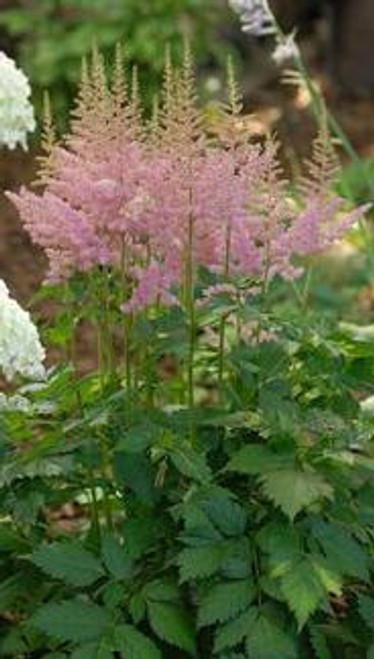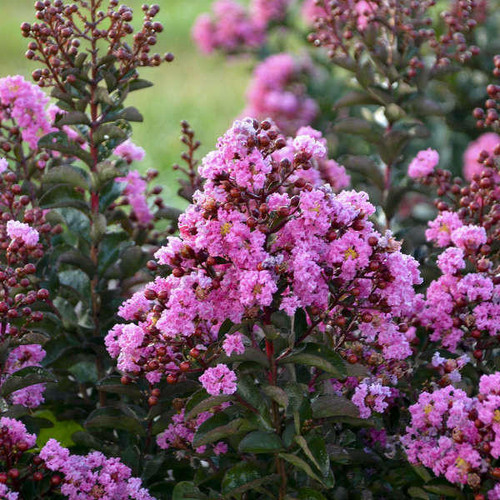Product Description
Astilbe 'Dark Side of the Moon' PPAF CPBRAF (4) 1-gallons
Proven Winners
Common Name: Astilbe
An instant classic for the landscape! 'Dark Side of the Moon' is the only dark leafed Astilbe with purple flowers that's on the market. Rich deep chocolate burgundy leaves form an incredibly attractive mound of foliage. Emerging leaves are yellow with a dark margin with a glossy sheen that become completely dark as they age. Dark stems hold raspberry buds that burst forth with rosy-purple flowers. This performs best both for growing and flowering in full sun in the north with adequate moisture but also grows in shade.
A member of Astilbe chinensis (Chinese Astilbe). A later blooming species useful for extending the bloom season into late summer. Foliage is deeply incised, coarsely textured, and often bronze-green in color. Flowers are borne on narrow, branched panicles. Though garden performance is far superior in moist soils, members of this species are moderately drought tolerant.
National Garden Bureau Green Thumb Award - Perennial -- 2023
Height: 20.0-22.0 Inches
Spread: 24.0-28.0 Inches
Scape Height: 28.0-34.0 Inches
Hardiness Zones: 4,5,6,7,8,9
Flower Color: Purple shades
Foliage Color: Near-black shades
Full Sun to Full Shade
Average to Consistent Water
Fertile Soil
Bloomtime: Late Summer
Bee Friendly
Deer and Rabbit Resistant
Seasonal Interest: Dried Seed Heads
Growth Rate: Medium
Border Plant, Container, Cut Flower, Cut Foliage, Dried Flower, Fragrant Flowers, Mass Planting, Specimen
Astilbe 'Dark Side of the Moon' is a unique and captivating perennial that stands out for its dramatic, dark foliage and late-blooming, rosy-purple flowers. It is a fantastic choice for adding contrast and texture to shade gardens and attracting pollinators. Here is a closer look at what makes it special:
Appearance:
- Flowers: 'Dark Side of the Moon' features tall, feathery plumes of rosy-purple flowers that bloom in late summer. The flowers are held on dark stems and rise above the foliage, creating a beautiful contrast.
- Foliage: The plant's most distinctive feature is its dark, almost black foliage. The leaves emerge yellow and gradually darken to a deep chocolate-brown, creating a striking backdrop for the flowers. The foliage remains attractive throughout the growing season, adding a touch of drama to the garden.
Growing Conditions:
- Light: Thrives in partial shade to full shade. It can tolerate some sun, especially in cooler climates, but it prefers protection from the hot afternoon sun.
- Soil: Prefers moist, well-drained soil that is rich in organic matter. It's important to keep the soil consistently moist, as 'Dark Side of the Moon' doesn't tolerate dry conditions well.
- Hardiness Zones: Hardy in USDA zones 4-8, making it suitable for a wide range of climates.
Uses:
- Shade Gardens: Its shade tolerance and dramatic foliage make it a perfect choice for shade gardens.
- Woodland Gardens: It is also a great addition to woodland gardens, where it can naturalize and create a beautiful, textured groundcover.
- Borders and Edging: 'Dark Side of the Moon' can be used to create stunning borders or to edge walkways and garden beds.
- Containers: It is also well-suited for containers, adding a touch of elegance to patios and balconies.
- Water Gardens: Its tolerance for moist conditions makes it a good choice for planting near ponds or water features.
Additional Benefits:
- Late-Blooming: It blooms later than most other Astilbe varieties, extending the season of interest in the garden.
- Attracts Pollinators: The flowers attract butterflies and other pollinators to the garden.
- Deer and Rabbit Resistant: The foliage is generally unappealing to deer and rabbits.
- Low Maintenance: It is a relatively low-maintenance plant that does not require much care once established.
Overall, Astilbe 'Dark Side of the Moon' is a unique and captivating perennial that is perfect for adding a touch of drama and attracting pollinators to shade gardens. Its dark foliage, beautiful flowers, and adaptability make it a favorite among gardeners.
(4) 1-gallon containers ready to plant, plants may be trimmed for shipping,
Other Details
The most important part of the plant is its root system. Healthy roots are the foundation of a healthy, vibrant plant. The type of plug container used is based on the specific needs of the plants. Perennials offered as bare root traditionally perform better when planted as bare root.Planted in a specialized mix, potted plants have well established root systems. Top growth stage will vary depending on the current life cycle and time of year when shipped. In Winter and early Spring dormant plants may be shipped. Dormant plants may be planted right away, even before the last frost date.
Most bare root varieties are field grown for at least one season, though Hemerocallis and Hosta are grown for two seasons. The bulk of the soil is removed during the harvesting process and the tops of most varieties are trimmed back to the crown. They are graded, packed in shredded aspen or sphagnum moss and stored in freezers until ready to be shipped.
See our Container Sizes and Bare Root Perennials pages for more information.
Plant information and care is provided in the Overview section, Plant Genus Page and general information is provided in the Planting Care & Guides. Additional questions can be asked on each Plant page.
Plant Spacing: Using the maximum mature spread or width of a plant to guide spacing, ensures space to grow to full size. To fill an area sooner, plant them closer together. Just remember, future thinning or transplanting may be needed.
Water: Keep a close eye on newly planted perennials, especially throughout the first growing year. Most early plant loss is due to too much or too little water!



















